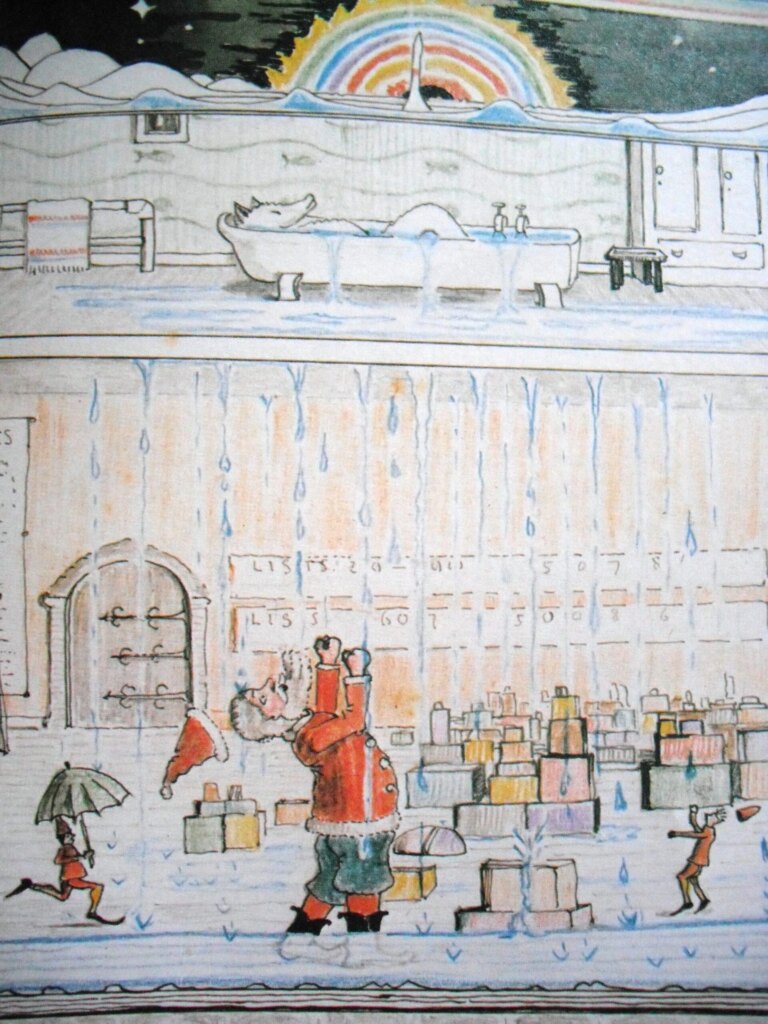How J.R.R. Tolkien spent 23 years writing letters from Father Christmas to his children at the North Pole, laying the groundwork for his later literary creations.
For 23 years, J.R.R. Tolkien did something very special for his young family. Each Christmas, he wrote them letters – these letters did not come from Tolkien himself, but from Father Christmas, from Santa Claus.
Decades later, the collection was released to the world. Tolkien fans from around the globe could engage with a festive family tradition, and marvel at the creativity and inventiveness of one of the English language’s best-loved authors.
It’s easy to associate Tolkien exclusively with Middle Earth and The Lord of the Rings. But he was a father, husband, and family man too, and this greatly influenced his career.
Tolkien’s Christmas Letters

First came John, born in 1917. Next, Michael in 1920, and Christopher in 1924. Finally, Priscilla was born in 1929. These were the four children of J.R.R. and Edith Tolkien, and to their parents, they were the whole world.
Christmas is always a special time. But it’s that little bit more special when we are still young. Tolkien understood this, and so he set out to make Christmas as wonderful as possible for each of his four children. Beginning in 1920, when John was three, and concluding in 1943, when Priscilla was 14, the author penned a series of letters from Father Christmas, updating the children on the goings-on at the North Pole, and on the business of delivering presents to youngsters around the world.

Each of the letters was painstakingly illustrated, demonstrating the artistic skill and vision of their creator. They were stamped with a seal, telling the children where they had come from – which was, of course, the North Pole.
Weaving a Fantasy World
Tolkien could simply have delighted his children with a few short words and a pretty picture of Santa Claus. But the author was not one to do things by halves. After all, this is a writer who is famous for developing an entire language for his best-known fictional creation, The Lord of the Rings.

And so J.R.R. Tolkien set about creating a fantasy world for his children to lose themselves in. Yes, Father Christmas is busy preparing for the approaching holiday season, organizing gifts, and readying his sleigh and team of reindeer for the arduous journey ahead. But there are also other adventures going on, such as rescuing the Man in the Moon after his home is accidentally destroyed, or doing battle with the evil goblins who are out to ruin everything.
As with much of Tolkien’s work, this is only partly fantasy. There are other themes at play too; real world themes that reflected Tolkien’s own views. The goblins, for example, are analogous to the growing storm of Nazism and Fascism that was about to engulf the world in the late 1930s. The author’s young children may not have been aware of the depth of meaning in these letters at such a tender age, but Tolkien himself certainly was.
From Family Tradition to Published Work
By the final years of his life, J.R.R. Tolkien had become a literary star. The Middle Earth novels were critically and financially successful, giving their author an impressive income and even landing him a Nobel Prize nomination in 1961.

After his beloved wife Edith died in 1971, Tolkien struggled with the loss. Despite being made a CBE in 1972, and receiving an honorary Doctorate from Oxford University that same year, he found it difficult to adjust to life without the woman he’d been married to for 55 years. In 1973, Tolkien himself passed away, less than two years after Edith.
Tolkien’s death ignited a newfound interest in his work, and several posthumous works and collections were released. One such work was The Silmarillion – an exploration of the mythology and folklore of Middle Earth, and a well-loved cornerstone of the LOTR universe. Another was The Father Christmas Letters.
In 1976, Baillie Tolkien – wife of Christopher – edited The Father Christmas Letters, and released them to the world. These were the short works of fiction that had so delighted her husband and his siblings in their youth, and now they would delight legions of Tolkien fans across the world.

And they still do, to this day. In 2023, actor Jim Broadbent performed a reading of one of these letters as part of a carol service at Westminster Abbey. The event was broadcast on British television on Christmas Eve, reinvigorating public interest in Tolkien’s remarkable, decade-spanning, work.
The Endless Inventiveness of J.R.R. Tolkien
J.R.R. Tolkien was an artist capable of unique vision and astonishing inventiveness. With his Middle Earth series, he created a universe that has enraptured millions of readers and movie-goers around the globe.
With this in mind, it makes sense that the author would pour this creativity and innovation into the letters he produced for his children.

In fact, some believe these letters directly fuelled the creative process for Lord of the Rings. The Hobbit, the first book in The Middle Earth series, was published in 1937. But Tolkien was working on it – in one form or another – since the early 1930s. Tolkien fans have posited that his annual Christmas letters helped him develop some of the characters and scenarios that would later populate his more famous works.
Some of have even found elements of Gandalf in the character of Father Christmas, though this remains up for debate.
There’s a reason The Lord of the Rings remains popular to this day. It’s a staggering work of literary prowess and creative agility. While The Father Christmas Letters don’t quite ignite the imagination in the same way as Tolkien’s more famous works, they are still evidence of an astonishing and unique author at work. For Tolkien fans, or for those who simply love a good festive yarn, this collection is not to be overlooked.
Join our community of 1.5M readers
Like this story? You'll love our free weekly magazine.








